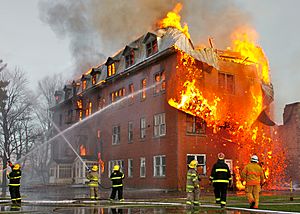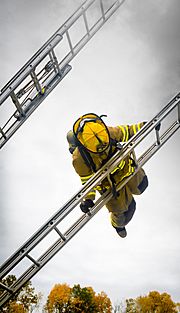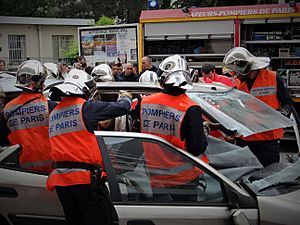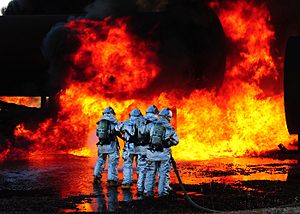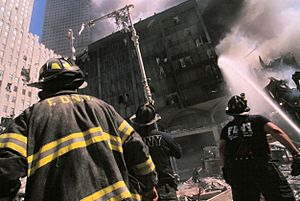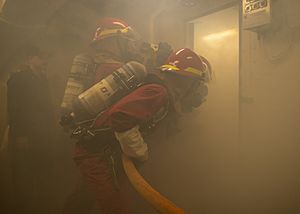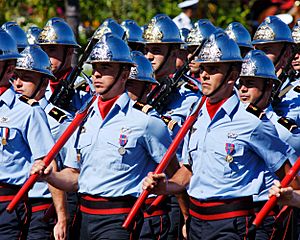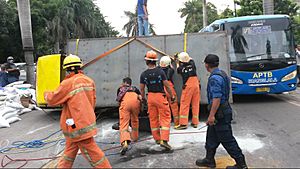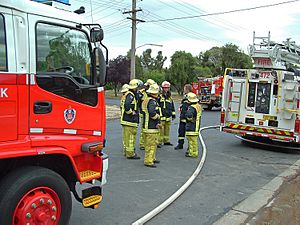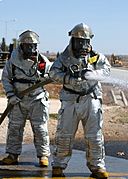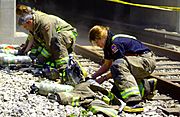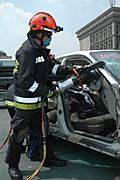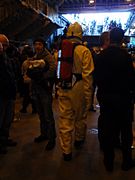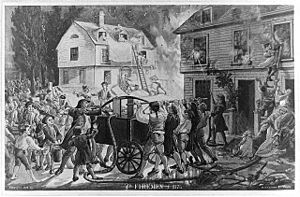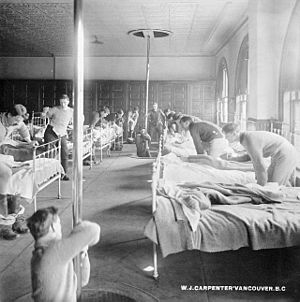Firefighter facts for kids

Firefighter training a junior volunteer firefighter
|
|
| Occupation | |
|---|---|
| Synonyms | fireman (PL: firemen) firewoman (PL: firewomen) |
|
Activity sectors
|
Rescue, fire protection, civil service, public service, public safety |
A firefighter is a first responder who is trained to control and put out fires. They also rescue people from dangerous situations or places where they are trapped. Sometimes, male firefighters are called firemen and female firefighters are called firewomen.
The fire service, also known as the fire brigade or fire department, is one of the three main emergency services. Firefighters work in many places, from urban areas to aboard ships, all around the world.
Firefighters regularly practice their skills during training. This helps them stay safe and ready for emergencies. Basic firefighting skills are usually taught at special fire academies or training courses. Depending on where they work, firefighters might also learn extra skills and get more certifications.
Firefighters work closely with other emergency teams like the police and emergency medical service (EMS). Sometimes, a firefighter's job can include tasks from both. Fire investigators or fire marshals look into what caused a fire. If a fire was started on purpose (arson) or by accident due to carelessness (negligence), their work can involve law enforcement. Firefighters may also provide some emergency medical service.
Contents
What Firefighters Do
Putting Out Fires
A fire needs three things to burn: fuel, oxygen, and heat. This is often called the fire triangle. Sometimes, a fourth element, a chemical chain reaction, is added, making it the fire tetrahedron. Firefighters aim to remove at least one of these elements to put out a fire. Most often, they use water. However, some fires need other materials like foam or special dry chemicals. Firefighters use many tools, including ladder trucks, pumper trucks, tanker trucks, fire hoses, and fire extinguishers.
Fighting Building Fires
When a fire is in a building, smoke, water, and burning pieces can cause a lot of damage. One of the first things fire crews do is turn off utilities like gas and electricity. They might also need to force their way into the building to get inside. Special steps and equipment are needed if dangerous materials are stored there.
Firefighters can fight building fires from the "inside" or "outside," or both. Inside crews use hoses to go into the building, find the fire, and cool it with water. Outside crews might spray water into windows or other openings. They also spray water on anything nearby that could catch fire.
Buildings made of wood burn differently than those made of concrete. A "fire-resistant" building is designed to keep a fire in a small area. This helps keep other floors safe from smoke and damage. All buildings that are on fire or suspected of being on fire must be emptied.
Some firefighting methods might look destructive, but they serve important purposes. For example, during ventilation, firefighters might make holes in the roof or floors (vertical ventilation). Or they might open windows and walls (horizontal ventilation). This helps remove smoke and hot gases from inside the building. Ventilation also helps firefighters see better to find people faster. It saves lives by releasing poisonous gases. Vertical ventilation is also key for firefighter safety during a flashover or backdraft. A flashover is when everything in a room suddenly bursts into flames due to intense heat. A backdraft happens when oxygen suddenly rushes into a hot, smoky, oxygen-starved area, causing an explosion. Releasing flammable gases through the roof prevents backdrafts. Removing heat can reduce the chance of a flashover. Flashovers are very hot and explosive, often causing serious harm to firefighters.
When fighting a building fire, firefighters try to protect people's belongings. They move property to the center of a room and cover it with a heavy cloth called a salvage cover. They also remove water and cover broken windows or roofs. This helps prevent more damage after the fire.
Fighting Wildfires
Wildfires, also called bushfires in Australia, need special ways to fight them. In many countries, like Australia and the United States, local volunteer firefighters often handle these fires. Wildfires can help new plants grow, so sometimes they are left to burn. But the main goals are to save lives and property and prevent harm to nature.
Airport Firefighting
Airports have special firefighters for emergencies on the ground. Because aviation emergencies can involve many people, it's super important for emergency teams to arrive very quickly. Airport firefighters quickly secure the aircraft, its crew, and passengers from dangers, especially fire. They are highly trained in using special foams, dry chemicals, and clean agents to put out burning aviation fuel.
Rescue Operations
Firefighters rescue people from dangerous situations. This includes burning buildings and crashed vehicles. They also handle complex rescues like those from collapsed buildings or tight spaces. Many fire departments, especially in the United Kingdom, call themselves a fire and rescue service because of this. Big fire departments, like the New York City Fire Department, have special teams for advanced technical rescues. In developed countries like the United States, building fires have become less common. So, rescues other than fires make up more of a firefighter's work.
Emergency Medical Services
Firefighters often provide some emergency medical care. In some places, firefighters only have basic first aid training. Medical calls are handled by a separate emergency medical services (EMS) team. In other places, firefighters commonly respond to medical calls. This is because there are more medical emergencies and fewer fires.
In these departments, firefighters are often certified as emergency medical technicians (EMTs) to give basic life support. Sometimes, they are even certified as paramedics to give advanced life support. In the United Kingdom, fire services and EMS are separate. But they have recently started a program where fire service co-responders help with medical calls. Firefighters might respond in a fire engine or a smaller response car.
Dealing with Hazardous Materials
Fire departments are usually the first to respond to hazardous materials incidents. Special firefighters, called hazardous materials technicians, are trained to identify chemicals, control leaks and spills, and clean up dangerous substances.
Fire Prevention
Fire departments often give advice to the public on how to prevent fires at home and work. Fire inspectors or fire marshals check businesses to make sure they follow current building fire codes. These codes help buildings resist fire spread, find dangers, and ensure people can safely leave.
Fire suppression systems are proven to control and put out unwanted fires. Many fire officials suggest that every building, including homes, should have fire sprinkler systems. Working sprinklers in a home greatly reduce the risk of dying in a fire. In small rooms, one or two sprinklers can cover most areas.
Other ways to prevent fires include reducing known dangers or stopping unsafe actions before they cause trouble. This is done through presentations, safety brochures, news articles, public safety announcements (PSAs), or displays. A top priority for fire prevention teams is to make sure every home has working smoke alarms. They also teach people about fire safety and how to plan an escape route and meeting point.
Fire investigators are experienced firefighters trained to find out what caused a fire. They investigate if a fire was an accident or set on purpose. Some fire investigators have police powers to investigate and arrest people suspected of arson.
Firefighter Safety and Health
Immediate Dangers
Fires and Heat

To stay safe from the dangers of fighting fires, firefighters wear and carry special protective gear. A self-contained breathing apparatus (SCBA) gives them air through a full face mask. This protects them from smoke inhalation, toxic fumes, and superheated gases. A special device called a Personal Alert Safety System (PASS) is often worn. It sounds an alarm if a firefighter stops moving for a certain time or if they turn it on manually. The PASS device helps other firefighters find someone in trouble.
Firefighters often carry personal self-rescue ropes. These ropes are usually 30 feet long. They can help a firefighter escape from a high window in a somewhat controlled way.
Heat injury is a big problem for firefighters. They wear insulated clothing and can't easily cool down from physical effort. Finding heat issues early is vital to stop dehydration and heat stress from becoming dangerous. Early heat stress affects how well they think. This, combined with working in dangerous places, makes heat stress a critical issue. New technology can monitor a firefighter's vital signs and exertion levels. This information is sent over their radio. This gives an early warning about physical stress.
Building Collapses
Another main cause of danger during firefighting is when a burning building collapses. This can be a wall, floor, ceiling, roof, or truss system. Building collapses often happen without warning. They can trap or crush firefighters inside. To prevent this, all firefighters on duty should stay in touch with their commander. They should also have a personal alert safety system device and use radio communication at all incidents.
Traffic Accidents
In the United States, 25% of firefighter deaths are from traffic collisions. These happen while they are going to or coming back from an incident. Other firefighters have been hurt or killed by vehicles at the scene of an emergency. To prevent this, fire departments often require firefighters to wear a bright yellow reflective vest. This makes them more visible to drivers on public roads.
During Cleanup After a Fire
After a fire is put out, cleaning up the debris can be risky for workers. Many dangerous substances are found in fire debris. Breathing in dust can cause lung diseases. Inhaling asbestos can also lead to serious lung illnesses. Metals from burnt electronics or cars can expose workers to harmful substances. Some chemicals from burning materials can also cause cancer.
Safety dangers during cleanup include the risk of debris catching fire again. There's also a risk of electrocution from damaged electrical lines or if water touches electrical equipment. Burned buildings can be unstable and might suddenly collapse.
Standard personal protective equipment for fire cleanup includes hard hats, goggles, heavy work gloves, earplugs, safety boots, and fall protection gear. To prevent electrical injury, workers assume all power lines are live until confirmed off. They also use proper safety equipment. Good respiratory protection helps against hazardous substances. Proper ventilation can avoid or reduce exposure to dangerous materials. If ventilation isn't enough, N95 respirators can be used.
Long-Term Health Risks
Heart Disease
Firefighting has long been linked to heart problems. In the United States, the most common cause of death for firefighters on duty is sudden heart failure. This accounts for about 45% of these deaths. Besides personal health factors, job exposures can greatly increase a firefighter's risk. Toxic gases put firefighters at a higher risk for heart conditions. For example, carbon monoxide is in almost all fires. Hydrogen cyanide forms when paper, cotton, and plastics burn. These substances can stop oxygen from getting to the body, which can hurt the heart. Also, being around particulate matter in smoke for a long time is linked to hardening of the arteries. Loud noises can also lead to high blood pressure and heart disease. Other factors like stress, heat stress, and hard physical work also increase the risk of heart problems.
During fire suppression, a firefighter's heart rate can go very high. This can trigger a heart event. For example, a fast heart rate (tachycardia) can cause plaque to break off and block a small part of the heart, leading to a heart attack. This, along with unhealthy habits, can be very dangerous for firefighter health.
Cancer Risk
The risk of cancer in firefighters is a growing concern. Studies suggest that firefighters may have a higher risk for certain cancers due to their exposure at fire scenes. Large international studies also show that firefighters have higher rates of cancer.
A 2015 study found that firefighters have a higher risk for certain types of cancer. They had mesothelioma, which is caused by asbestos exposure, at twice the rate of other workers. Younger firefighters (under 65) also had higher rates of bladder cancer and prostate cancer. Early research in 2015 showed a link between time spent fighting fires and deaths from lung cancer and leukemia in firefighters.
Firefighters regularly come across carcinogenic materials (things that cause cancer) and dangerous pollutants. Dozens of chemicals known to cause cancer have been found at fire scenes. Studies have shown that firefighters breathe in or get these cancer-causing compounds on their skin. These chemicals can also be found on their turnout gear and other equipment. Some of these compounds have been shown to enter firefighters’ bodies.
Firefighters often work 24-hour shifts or longer, and may respond to emergencies at night. Night shift work has been classified as possibly causing cancer in humans. Some firefighters also work with hazardous materials and are trained to clean up spills. When fighting a fire or cleaning up hazardous materials, there is a risk of harmful chemicals touching their skin if they get through their personal protective equipment (PPE). In June 2022, a major health agency classified being a firefighter as "carcinogenic to humans."
Firefighters can also be exposed to radiation (alpha, beta, and gamma radiation).
Most research on firefighter cancer risk has focused on full-time firefighters in cities. Wildland firefighters are specially trained to control forest fires. They often create fire lines by cutting down trees and digging up grass to remove fuel for the fire. Wildland firefighting is very demanding and has many dangers. Wildland firefighters often hike for miles carrying heavy gear during wildfire season. Unlike structural firefighters, wildland firefighters usually don't wear respiratory protection. So, they might breathe in particulate matter and other compounds from wildfires. They also use prescribed fires to burn fuel under controlled conditions.
Because there isn't one main source of data, studying cancer rates among firefighters has been hard. In 2018, the U.S. Congress passed a law to create the National Firefighter Registry. This registry collects data on cancer rates among U.S. firefighters.
Mental Stress
Like other emergency workers, firefighters may see upsetting things during their careers. This makes them more likely to have mental health issues like post-traumatic stress disorder (PTSD). Long-term stress can cause symptoms like anxiety, irritability, nervousness, and problems with memory and focus. These can lead to anxiety and depression.
The mental stress of firefighting has many causes. There are the difficult things they see on duty. There are also things they miss by being on duty. Firefighter schedules change by district. Some work 48 hours on and 48 hours off. Others work 24 hours on and 72 hours off. Missing a child's first steps or a school event can be very hard on first responders. There is also the stress of working different shifts than a spouse or being away from family.
When not at an emergency, firefighters stay at fire stations. They eat, sleep, and do other tasks during their shifts. So, sleep disruption is another job hazard they might face.
Hearing Loss
Another long-term risk for firefighters is being exposed to loud sounds. This can cause noise-induced hearing loss (NIHL) and tinnitus (ringing in the ears). NIHL first affects how people hear high-pitched sounds. With more exposure, it spreads to other sounds. Many speech sounds become harder to hear, which makes communication difficult. NIHL is caused by sounds at or above 85 dBA (a measure of sound level).
The time it takes for sound to cause damage depends on how loud it is. Common causes of loud sound exposure are sirens, travel to and from fires, fire alarms, and work tools. Traveling in an emergency vehicle can expose a person to 103 to 114 dBA of sound. Sirens often produce about 120 dBA. Even short exposures to these loud sounds can cause permanent hearing loss over time. Besides loud sounds, some chemicals can also harm hearing.
Firefighters often have high rates of hearing loss, which increases with age and years on the job. Programs to prevent hearing loss have been started in many stations. These programs have helped lower the rate of NIHL in firefighters. Other efforts have been made to reduce sound exposure, like making firetruck cabs quieter. The NFPA (National Fire Protection Association) sets health standards for firefighters. This includes hearing tests. While NIHL is a risk, it can also be a safety concern. Good communication with coworkers and victims is essential for safety. Hearing protection devices are used by firefighters. Earmuffs are common because they are easy to put on quickly. Many fire departments use hearing protection with built-in communication devices. This lets firefighters talk to each other at safe sound levels while blocking out dangerous noise.
How Fire Services Work
Types of Coverage
In countries with a full fire service, fire departments must be able to send firefighters to emergencies at any time. They need to arrive within minutes. In cities, this means full-time paid firefighters usually work in shifts, with some on duty every night. But in villages and small towns, it might not make sense to hire full-time firefighters. Their services might not be needed for days. So, many fire departments have firefighters who are on call for long periods. They might have other regular jobs outside of firefighting.
Whether they are paid or not depends on the country. In the United States and Germany, volunteer fire departments provide most of the coverage in rural areas. In the United Kingdom and Ireland, true volunteers are rare. Instead, "retained firefighters" are paid for responding to incidents. They also get a small salary for being on call for long periods. In both the UK and Ireland, retained firefighters make up most of the active firefighting staff. Their training and skills are similar to full-time firefighters. Retained firefighters must live or work close to their assigned fire station.
Firefighting Around the World
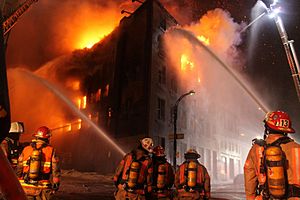
A big difference between fire services in different countries is the mix of full-time and volunteer (or on-call) firefighters. In the United States and United Kingdom, big city fire departments are almost all full-time firefighters. But in Germany and Austria, volunteers play a big role, even in large cities like Berlin. Often, smaller cities have a mix of full-time and volunteer firefighters. This is called a combination fire department in the United States. In Chile and Peru, all firefighters are volunteers.
Another difference is how fire services are organized. Some countries, like the Czech Republic, have one national fire service. Others, like Australia and the United Kingdom, organize fire services by regions or states. In the United States, Austria, Germany, and Canada, fire departments are run by local cities or towns.
Unusually, Singapore and parts of Switzerland have fire service conscription. This means people might be required to serve as firefighters. In Germany, conscription can also be used if a village doesn't have a working fire service. Other unique setups include Denmark, where private companies run most fire services. In France, two fire services are part of the armed forces.
Firefighting equipment and tactics also vary around the world. For example, American fire departments use more aerial appliances (like ladder trucks). They often split into engine and ladder companies. In Europe, where streets are narrower, aerial appliances are mainly for rescues. Firefighters can switch between working on an engine and an aerial appliance.
Finally, how much firefighters are involved in emergency medical services also differs globally.
Communication and Command
Quick and accurate handling of fire calls is very important for a successful outcome. Fire department communications are key. This includes how the public calls for help, how the center tells firefighters about an emergency, and how information is shared at the scene. One way is to use a megaphone to talk.
A telecommunicator (often called a 000 Operator in Australia) has a vital role. They must handle calls from people who are often stressed and unknown. They need to get full and reliable information from the caller. They also prioritize requests for help. It's the dispatcher's job to bring order to chaos.
Some fire departments are big enough to have their own dispatchers. But most rural and small areas use a central dispatcher for fire, rescue, and police services.
Firefighters are trained to use communications equipment. They receive alarms, give and get commands, ask for help, and report on conditions. Firefighters from different agencies often help each other. They also work with other emergency services. So, it's important to have clear ways to lead and share information. The U.S. Federal Emergency Management Agency (FEMA) has a National Incident Management System. Part of this system is the Incident Command System.
All radio communication in the United States needs permission from the Federal Communications Commission (FCC). So, fire departments using radio equipment must have FCC licenses.
Ranks in Fire Departments
Many firefighters are official members with ranks, similar to the military or police. They usually don't have general police powers. However, some fire safety officials, like fire marshals, do have police powers for enforcing rules and controlling emergency situations. In some countries, firefighters carry or can get firearms.
The names for firefighting roles vary by country. The basic group of firefighters is called a "company" in many countries, like the United States. Its members usually work on the same engine. A "crew" or "platoon" is a smaller group within a company who work on the same shift. In British fire services, firefighters at each station are often organized into "watches." Several watches work in shifts, with a separate "crew" for each engine.
Firefighter Equipment
-
British sailors in firefighting gear on a ship.
Here is a list of some common equipment firefighters use:
- Hand tools, such as:
- Flat-head and pick-head axes
- Pike poles
- Halligan bars
- Flashlights
- Spanner wrenches
- Circular saws and chain saws
- Hydraulic rescue tools like spreaders, cutters, and rams
- Personal protective equipment ("PPE") designed for water and high heat, such as:
- Bunker gear, including turnout jacket and pants
- Self-contained breathing apparatus (SCBA)
- Helmet, face mask, and visor
- Safety boots, gloves, and special fire-resistant hoods
- Personal alert safety system (PASS) device
- Handheld radio, pager, or other communication devices
- Thermal imaging camera (to see heat)
- Gas detector
History of Firefighting
People have fought fires for a very long time. The first organized group of professionals fighting building fires was in ancient Egypt. In the Roman Republic, fire brigades were private businesses. But during the time of Emperor Augustus, the first truly public and professional firefighting service was created. They were called the Vigiles. They were trained, paid, and equipped by the state. They also served as a night watch and city police force.
The earliest American fire departments were made of volunteers. These were citizens who gave their time to help protect their community. As more towns grew, the number of volunteer departments greatly increased.
In 1853, the first career fire department in the United States was started in Cincinnati, Ohio. Four years later, the St. Louis Fire Department followed. Large cities began hiring full-time staff to handle more calls.
City fire departments get their money from city taxes. They share a budget with other public services like the police department. Municipal fire departments have their own taxes and budgets. City fire departments report to the mayor. Municipal departments report to elected board officials.
Fundraising for Fire Departments
Sometimes, firefighters themselves raise money for equipment, especially for volunteer groups. Events like pancake breakfasts and chili feeds are common in the United States. Social events like dances, fairs, and car washes are also used to raise money.
See also
 In Spanish: Bombero para niños
In Spanish: Bombero para niños


